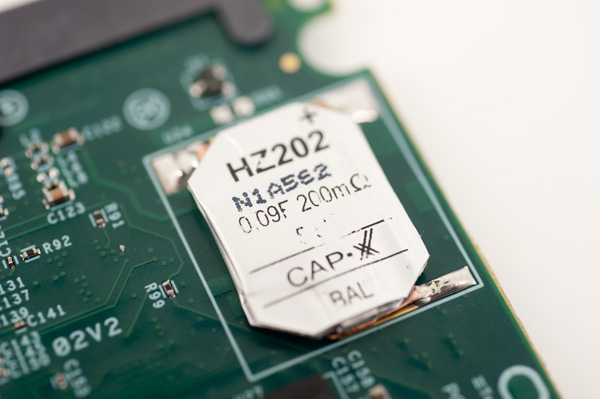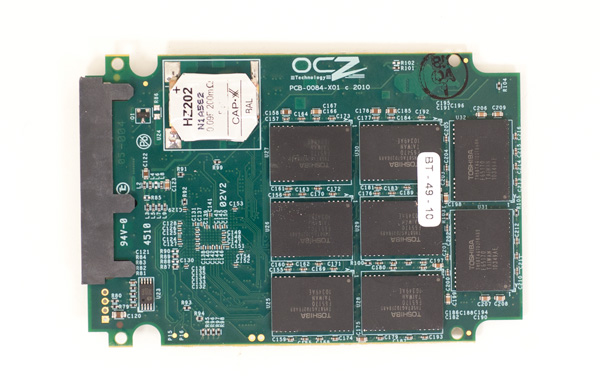OCZ Vertex 3 Pro Preview: The First SF-2500 SSD
by Anand Lal Shimpi on February 17, 2011 3:01 AM ESTToday: Toshiba 32nm Toggle NAND, Tomorrow: IMFT 25nm
The Vertex 3 Pro sample I received is a drive rated at 200GB with 256GB of NAND on-board. The SF-2682 controller is still an 8-channel architecture and OCZ populates all 8 channels with a total of 16 NAND devices. OCZ selected Toshiba 32nm Toggle Mode MLC NAND for these early Vertex 3 Pro samples however final shipping versions might transition to IMFT 25nm. The consumer version (Vertex 3) will use IMFT 25nm for sure.
Each of the 16 NAND devices on board is 16GB in size. Each package is made up of four die (4GB a piece) and two planes per die (2GB per plane). Page sizes have changed. The older 34nm Intel NAND used a 4KB page size and a 1MB block size. For Toshiba's 32nm Toggle NAND pages are now 8KB and block size remains unchanged. The move to 25nm will finally double block size as well.
Remember from our earlier description of SandForce's architecture that its data redundancy requires a single die's worth of capacity. In this case 4GB of the 256GB of NAND is reserved for data parity and the remaining 66GB is used for block replacement (either cleaning or bad block replacement). The 200GB drive has a 186GB formatted capacity in Windows.
This is a drive with an enterprise focus so the 27.2% spare area is not unusual. You can expect the consumer versions to set aside less spare area, likely at little impact to performance.

The 0.09F supercap, a feature of the enterprise level SF-2500 controller. This won't be present on the client Vertex 3.
The Vertex 3 Pro is still at least a month or two away from shipping so pricing could change, but right now OCZ is estimating sales at between $3.75 and $5.25 per GB. The client focused Vertex 3 will be significantly cheaper - I'd estimate somewhere north (but within range) of what you can currently buy Vertex 2 drives for.
| OCZ Vertex 3 Pro Pricing | |||||
| 100GB | 200GB | 400GB | |||
| MSRP | $525.00 | $775.00 | $1350.00 | ||
| Cost per GB | $5.35/GB | $3.875/GB | $3.375/GB | ||
Both the Vertex 3 and Vertex 3 Pro are expected to be available as early as March, however as always I'd be cautious in jumping on a brand new controller with brand new firmware without giving both some time to mature.












144 Comments
View All Comments
FCss - Thursday, February 17, 2011 - link
"My personal desktop sees about 7GB of writes per day." maybe a stupid question but how do you check the amount of your daily writes?And one more question: if you have a 128Gb SSD and you leave let's say 40Gb unformated so the user can't fill up the disk, will the controller use this space the same way as it would belong to the spare area?
Quindor - Thursday, February 17, 2011 - link
I use a program called "HDDLED" for this. It shows you some easily accessible leds on your screen and if you hover over it, you can see the current and total disk usage since your PC was booted up.FCss - Thursday, February 17, 2011 - link
thanks, a great softwareBreit - Thursday, February 17, 2011 - link
isn't the totally written bytes to the drive since manufacturing be part of the smart data you can read from your drive? all you have to do then is noting down the value when you boot up your pc in the morning and subtract that from the actual value you read there the next day.Chloiber - Thursday, February 17, 2011 - link
Or you can just take the average..marraco - Thursday, February 17, 2011 - link
Vertex 2 takes advantage of unformated space. So OCZ advices to leave 20% of space unformated , (although to improve garbage collection, but it means that unformated space is used)7Enigma - Thursday, February 17, 2011 - link
Comon Anand! In your example you have 185GB free on a 256GB drive. I think that is the least likely scenario that paints an overly optimistic case in terms of write life. Everyone knows not to completely fill up their drive but are you telling me that the vast majority of users are going to have 78% of their drive free at all times? I just don't buy it.The more common scenario is that a consumer purchases a drive slightly larger then needed (due to how expensive these luxuries still are). So that 256GB drive probably will only have 20-40GB free. Do that and that 36 days for a single use of the NAND becomes ~5-8 days (no way to move static data around at this capacity level). Factor in write amplification (0.6X to 10X) and you lower the time to between 4-25 years for hitting that 3000X cap.
Still not a HUGE problem, but much more relevant then saying this drive will last for hundreds of years (not counting NAND lifespan itself).
7Enigma - Thursday, February 17, 2011 - link
Bah I thought the write amplification was 1.6X. That changes the numbers considerably (enough that the point is moot). I still think the example in the article was not a normal circumstance but it seems to still not be an issue.<pie to face>
mark53916 - Thursday, February 17, 2011 - link
Encrypted files are not compressible, so you won't get any advantagefrom the hardware write compression.
7Enigma - Thursday, February 17, 2011 - link
Hi Anand,Looks like one of the numbers is incorrect in this chart. Right now it shows LOWER performance after TRIM then when the drive was completely full. The 230MB/sec value seems to be incorrect.